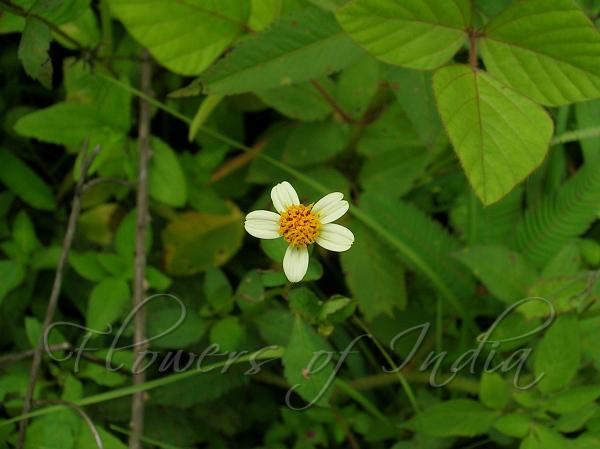|
| Beggar Tick |
|

|

| File size | 688964 |
| Original date | 7/6/05 1:01 PM |
| Resolution | 2048 x 1536 |
| Flash | Flash did not fire, auto |
| Focal length | 8.0mm |
| Exposure time | 1/281s |
| Aperture | 5.5 |
| Focus Distance | |
| Metering Mode | Partial |
| Camera make | NIKON |
| Camera model | E3700 |
| Sensor type |
|
|
|
|
Photo: |
Botanical name: Bidens pilosa Family: Asteraceae (Sunflower family)
Synonyms: Bidens orientalis, Bidens minor, Bidens leucanthemus
Synonyms: Bidens orientalis, Bidens minor, Bidens leucanthemus
Beggar Tick is an annual forb of slender habit,
growing up to 1.8 meters tall. It grows aggressively on disturbed land
and often becomes weedy. The leaves are oppositely arranged and pinnate
in form with three to five toothed, ovate-to-lanceshaped leaflets. The
leaf-stalks are slightly winged. The plant may flower at any time of
the year, but in temperate regions it blooms mainly in summer and
autumn. Flowers are borne in small heads on relatively long
flower-cluster-stalks. The heads bear about four or five broad white
ray florets, surrounding many tubular yellow disc florets. The fruits
are slightly curved, stiff, rough black rods, tetragonal in cross
section, about 1 cm long, with typically two to three stiff, heavily
barbed awns at their distal ends. The fruits form star-shaped spherical
burrs about 1-2 cm in diameter. The barbed awns catch onto fur or
clothing, and can injure flesh. It is an effective means of seed
dispersal by animals. This mechanism has helped the plant become a
noxious weed in temperate and tropical regions. In NE India, young
leaves and shoots are eaten raw or cooked as vegetable with fish.
Beggar Tick is native to the Americas. In India it can be seen in the
Himalayas, up to an altitude of 2500 m.
Medicinal uses: Beggar Tick is used in China
and NE India in folk medicine. Either the whole plant or different
parts, have been reported to be useful in the treatment of more than 40
disorders such as inflammation, immunological disorders, digestive
disorders, infectious diseases, cancers, metabolic syndrome, wounds,
and many others.
Beggar Tick is used in China
and NE India in folk medicine. Either the whole plant or different
parts, have been reported to be useful in the treatment of more than 40
disorders such as inflammation, immunological disorders, digestive
disorders, infectious diseases, cancers, metabolic syndrome, wounds,
and many others.
Medicinal uses:
 Beggar Tick is used in China
and NE India in folk medicine. Either the whole plant or different
parts, have been reported to be useful in the treatment of more than 40
disorders such as inflammation, immunological disorders, digestive
disorders, infectious diseases, cancers, metabolic syndrome, wounds,
and many others.
Beggar Tick is used in China
and NE India in folk medicine. Either the whole plant or different
parts, have been reported to be useful in the treatment of more than 40
disorders such as inflammation, immunological disorders, digestive
disorders, infectious diseases, cancers, metabolic syndrome, wounds,
and many others. | Identification credit: Tabish | Photographed in Manipur & Jammu & Kashmir. |
• Is this flower misidentified? If yes,